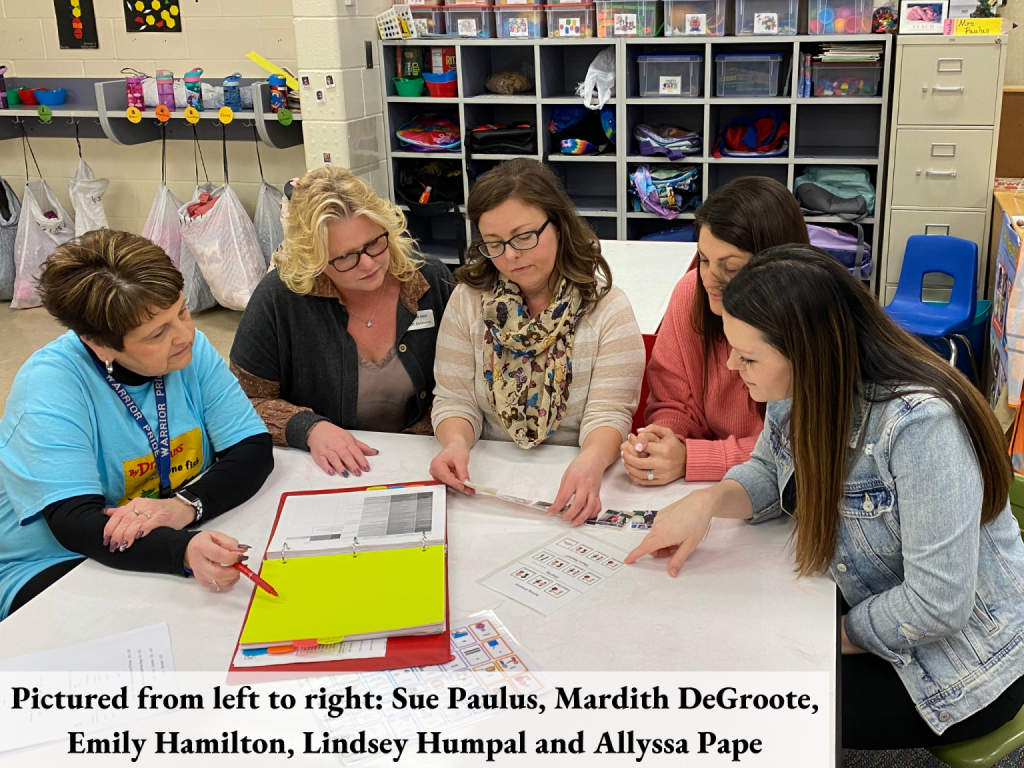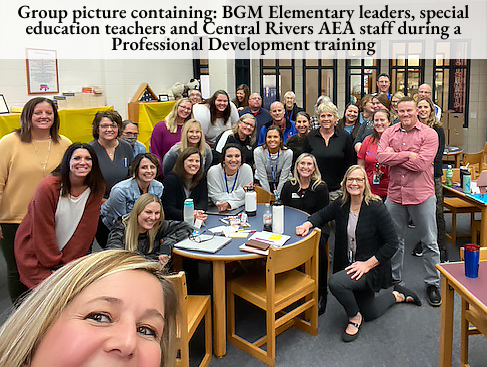Achieving Deeper Implementation with KickUp
A look at how Central Rivers AEA is utilizing a tool called KickUp to help school districts analyze data around new literacy learning. A deep dive into the data allows the school district to see a clearer picture of how well the implementation of a program is progressing and what areas might need to be addressed.

RRMR Sees Preschool Success with Implementation of SDI
Preschool is not just about naptime and recess. Preschool provides opportunities for children to learn about academics, self-control, listening and social and emotional skills. Children learn more than just how to take turns and share, it’s here that their excitement for the process of learning takes root. For the past three years, Rudd-Rockford-Marble Rock (RRMR) preschool has been using the Specially Designed Instruction (SDI) learning framework to make a difference in their students’ lives with support from Central Rivers AEA.
Specially Designed Instruction (SDI) is an instructional framework that is specifically customized to a particular student. This framework is very systematic – it helps school leaders and educators understand a student’s learning needs to design a learning plan that focuses on exactly what the student is missing and also what is needed to improve. While the SDI framework is designed to help students with disabilities, the process is helpful for all students.
The SDI team is made up of RRMR and Central Rivers AEA (CRAEA) leaders and staff including Jody Albertson, Regional Administrator with CRAEA, Lindsey Humpal and Allyssa Pape, Consultants for Early Childhood, Mardith DeGroote, Early Childhood Special Education Consultant, Bri Backer, Speech-Language Pathologist, Lisa Litterer, Occupational Therapist, Sue Paulus, preschool teacher, Emily Hamilton, Early-Childhood Special Educator and Makaela Hoffman, RRMR Elementary Principal.
Makaela Hoffman, RRMR Elementary Principal/Curriculum Coordinator, has noticed a positive difference in her school. “We are in our third year of SDI work and the difference it is making for our kids is remarkable! Helping teach students routines and expectations have catapulted learning in the classroom,” said Hoffman. “While the learning was great before, the added work around SDI has allowed RRMR to have one of the best preschool programs in North Iowa.”
“When we teach students what we want them to know and be able to do with modeling, pictures and re-teaching, it’s so fun to watch.” By creating routines for students, RRMR has created predictability amongst their preschoolers so they know what to expect. These routines have helped with behavior issues caused by lack of communication because the students know what is expected of them. “To watch the classroom unfold during our time of learning and growing has been amazing to watch,” said Hoffman.
“RRMR has enthusiastically engaged in the learning and implementation of strategies to help their students be successful. When we have other preschools in the area who are looking for a good model, we send them to RRMR,” said Albertson.
While the preschool has had immense success with SDI initiatives being implemented in their classrooms, the RRMR team recognizes that successful SDI implementation is hard work. “The Central Rivers AEA team has been phenomenal,” said Hoffman. “They have done the teaching, offered support and challenged the thinking of the team all while encouraging the team to keep moving forward. It’s hard work… really tough at times, but CRAEA has supported our team to keep going.” Now in year three, Hoffman and her team are excited to see the progress of their SDI work, with the help CRAEA has offered every step of the way.
Schools that wish to launch similar initiatives and programs need to know a few important details:
- Districts that are interested in SDI should just jump in if they have a desire to learn and make things better for their students.
- Everyone (teachers, paraeducators, administrators, etc.) can be a part of the SDI team and should be to gain the most momentum and support.
- Student success does not happen overnight – constant teaching/training updates will be necessary to ensure the best practices for students are happening.
- Contact your local AEA to help guide you through the process and get the proper resources and people involved.
For more information on the SDI framework or how CRAEA can support districts, contact Jody Albertson, CRAEA Regional Administrator at jalbertson@centralriversaea.org or Makaela Hoffman, RRMR Elementary Principal/Curriculum Coordinator at mhoffman@rockford.k12.ia.us.
Tailoring Professional Learning for a School District
Central Rivers AEA consultants Kelly Westley and Cari Teske engaged in year-long professional learning with the AGWSR Community School District around facilitating online and blended learning environments. The professional learning was customized to what AGWSR needed at that time to support teachers as they navigated the effects of COVID-19 on learning.

Central Rivers AEA Collaborates with Leadership from BGM Elementary School to Support Student Success
Student success is more than just having your students score well on tests. Student success is all about ensuring your students have the right resources and tools they need to help them learn and grow. That’s the vision at the Brooklyn-Guernsey-Malcom (BGM) Community School District, where seven years ago, district leadership saw a need to improve PreK-6 student proficiency. Today, they continue to learn how to best serve their students.
It all started with BGM’s data showing that their special education students were not meeting proficiency standards. Mary Sherwood, BGM Elementary School principal, began brainstorming ideas on how they could best serve and accommodate students in the classrooms. Central Rivers Area Education Agency (CRAEA) staff, Teri Boezinger, Jennifer Cline and Heather Gould began working alongside Sherwood and the school district’s leadership team to analyze student data to create specific student success initiatives, a major focus area for the agency.
To know what specific student success initiatives needed to be implemented, Sherwood, the district leadership team and CRAEA partners looked to the data. “We started with the Multi-Tiered Systems of Support (MTSS) and then focused on Tiers 1 and 2,” said Sherwood. “Our student data results showed that moving forward to Tier 3 was the next step for student success.” The three tiers in education include:
- Tier 1 = universal or core instruction
- Tier 2 = targeted or strategic instruction/intervention
- Tier 3 = intensive instruction/intervention
Specially designed instruction (SDI) is an instructional framework that is specifically customized to a particular student. While the SDI framework is designed to help students with disabilities, the process is helpful for all students because all students have needs. This initiative is aimed to develop and implement tools and processes to aid teachers in delivering effective instruction to improve the literacy outcomes for learners with disabilities. “I saw this initiative and signed up with CRAEA professional development (PD) and we’ve been going strong since with school-wide implementation.”
These initiatives are very systematic – it’s more than just ‘this student is struggling with reading, what can we do for them?’ Instead, an intensive and precise process is taken. The data shows what the student is missing and what exactly they need to improve. “This has been and continues to be a huge group effort from both CRAEA and BGM – we are all involved, sharing leadership and using our strengths to meet the needs of our students,” said Sherwood.
Teri Boezinger, Consultant for Literacy and PD Lead with CRAEA, helped with the development and implementation of professional learning for teachers and staff. “All of the professional learning and foundational beliefs for the initiatives are based upon the guiding principles from state-wide designed literacy initiative,” said Boezinger. “We make sure that we give personally-designed learning to our districts to ensure they get what they need.” These guiding principles are what lead the PD of the teachers and staff. “It’s a constant cycle of ‘what do you need?’ and ‘let’s give that to you and see it if helps improve learning.’”
Janelle Pirkl, Systems Coach and Consultant for Literacy with CRAEA, helped support the school improvement process and ensure implementation. “My role is to figure out what our best practice and instruction is and present that to teachers and staff in the most meaningful way possible,” said Pirkl. She believes keeping the strong connection between CRAEA and BGM is key to success. “Our partnership is successful because BGM has cultivated an environment in their school that is receptive, willing to learn and is welcoming to our training and coaching.” Pirkl doesn’t see it as professional development she’s presenting to the teachers and staff, but it’s professional development that they are doing together.
Reggie Rea, Instructional Coach and Jennifer Cline, Special Education Consultant with BGM Elementary, coach the teachers and staff. “We are constantly looking at our process and updating it to fit our needs,” said Rea. “Our SDI team has gained a lot from taking the literacy classes provided by CRAEA. We’ve created a systematic protocol to identify students that need interventions and how we’re problem-solving so we can get them targeted instruction.”
Weekly coaching sessions for teachers discuss student-specific concerns and apply the SDI framework to guide them. “I work directly with teachers to support the application of their learning with the students they serve,” said Cline. While specially-designed instruction is required by state-wide initiatives, BGM feels that it’s best practice for all students that are having difficulties. “When we are trying to match students to the correct interventions, we gather information to diagnose the learner’s needs and design an intervention to match those needs.”
Student success support is essential in all school districts. Schools that wish to launch similar programs and initiatives need to know a few important details:
- Your data shows you what you need. Be sure to closely study and analyze it.
- Understand this is not a “quick fix.” It is not a “one-year and you’re done,” approach – you are in it for the long haul and need to constantly update coaching styles and your core instruction.
- You may have to create some shifts in thinking with some staff/teachers with an initiative like this. It takes a lot of dedication and effort.
- The building leadership team is the first place to start – they must believe in such an initiative for it to be successful.
- There must be shared knowledge and common understanding to be successful.
- On-the-spot coaching and PD framework in the building are key.
- Data is constantly changing – interventions may need updating to ensure they are still working for students and leading them to improve and succeed.
- Contact your local AEA to help guide you through the process and get the proper resources and people involved.
For more information on the student success initiatives or how CRAEA can support districts, contact Heather Gould, CRAEA Regional Administrator at hgould@centralriversaea.org or Mary Sherwood, BGM Elementary Principal at msherwood@brooklyn.k12.ia.us.
